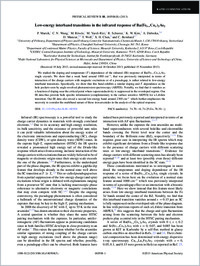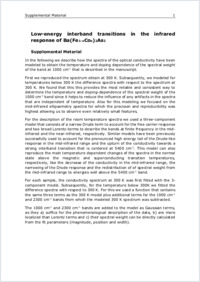Low-energy interband transitions in the infrared response of Ba(Fe1-xCox)2As2
- Marsik, Premysl University of Fribourg, Department of Physics and Fribourg Center for Nanomaterials, Switzerland
- Wang, Chen Nan University of Fribourg, Department of Physics and Fribourg Center for Nanomaterials, Switzerland
- Rössle, Matthias University of Fribourg, Department of Physics and Fribourg Center for Nanomaterials, Switzerland
- Yazdi-Rizi, M. University of Fribourg, Department of Physics and Fribourg Center for Nanomaterials, Switzerland
- Schuster, Roman University of Fribourg, Department of Physics and Fribourg Center for Nanomaterials, Switzerland
- Kim, Kyung Wan Department of Physics, Chungbuk National University, Cheongju, Korea
- Dubroka, Adam Department of Condensed Matter Physics, Faculty of Science, Masaryk University, Brno, Czech Republic - CEITEC-Central European Institute of Technology, Masaryk University, Brno, Czech Republic
- Munzar, Dominik Department of Condensed Matter Physics, Faculty of Science, Masaryk University, Brno, Czech Republic - CEITEC-Central European Institute of Technology, Masaryk University, Brno, Czech Republic
- Wolf, T. Karlsruher Institut für Technologie, Institut für Festkörperphysik, Karlsruhe, Germany
- Chen, X. H. Hefei National Laboratory for Physical Sciences at Microscale and Department of Physics, University of Science and Technology of China, Hefei, China
- Bernhard, Christian University of Fribourg, Department of Physics and Fribourg Center for Nanomaterials, Switzerland
-
15.11.2013
Published in:
- Physical Review B. - 2014, vol. 88, no. 18, p. 180508
English
We studied the doping and temperature (T) dependence of the infrared (IR) response of Ba(Fe1−xCox)2As2 single crystals. We show that a weak band around 1000 cm−1, that was previously interpreted in terms of interaction of the charge carriers with magnetic excitations or of a pseudogap, is rather related to low-energy interband transitions. Specifically, we show that this band exhibits a similar doping and T dependence as the hole pockets seen by angle resolved photoemission spectroscopy (ARPES). Notably, we find that it vanishes as a function of doping near the critical point where superconductivity is suppressed in the overdoped regime. Our IR data thus provide bulk specific information (complementary to the surface sensitive ARPES) for a Lifshitz transition. Our IR data also reveal a second low-energy band around 2300 cm−1 which further emphasizes the necessity to consider the multiband nature of these iron arsenides in the analysis of the optical response.
- Faculty
- Faculté des sciences et de médecine
- Department
- Département de Physique
- Language
-
- English
- Classification
- Physics
- License
-
License undefined
- Identifiers
-
- RERO DOC 209557
- DOI 10.1103/PhysRevB.88.180508
- Persistent URL
- https://folia.unifr.ch/unifr/documents/303556
Other files
Statistics
Document views: 117
File downloads:
- pdf: 160
- Supplementary material: 109

